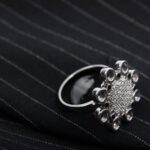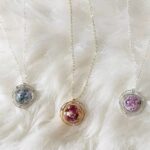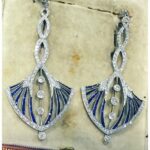Gold plated jewelry is a popular and affordable option for adding a touch of elegance to any ensemble. In this article, we will explore the best practices for caring for your gold plated jewelry to ensure it maintains its luster and beauty for years to come. Whether you’re new to wearing gold plated jewelry or have been enjoying its beauty for some time, understanding how to properly care for these pieces is essential in preserving their quality.
Understanding the difference between gold plated and solid gold jewelry is crucial in knowing how to care for each type. While solid gold is made entirely of the precious metal, gold plated jewelry features a thin layer of gold applied over another metal. This key distinction means that specific care and maintenance techniques are necessary to keep your gold plated pieces looking their best.
Proper storage is also an important factor in caring for your gold plated jewelry. Storing your pieces in a dry, air-tight container away from sunlight and humidity can help prevent tarnishing and damage.
Additionally, avoiding contact with harsh chemicals such as perfume, hairspray, and lotions can help preserve the integrity of the gold plating. In the following sections, we will delve into cleaning and maintenance techniques, common mistakes to avoid, DIY cleaning solutions, professional cleaning services, and conclude with final tips for maintaining your precious gold plated jewelry.
Understanding the Difference Between Gold Plated and Solid Gold
Gold plated jewelry has become increasingly popular as a more affordable alternative to solid gold. Understanding the difference between gold plated and solid gold is essential for properly caring for your jewelry and prevent premature damage or tarnishing.
Composition and Construction
Gold plated jewelry is made by covering a base metal, such as brass or sterling silver, with a thin layer of gold. This process creates the appearance of solid gold at a fraction of the cost. In contrast, solid gold jewelry is made entirely from the precious metal without any additional coating or layers.
Durability and Longevity
While solid gold is known for its durability and resistance to tarnishing, gold plated jewelry requires more delicate care to maintain its appearance. The thin layer of gold on plated jewelry can wear off over time, exposing the base metal underneath. This means that proper care is crucial to ensure the longevity of your gold plated pieces.
Value and Price
Solid gold jewelry holds its value and can be an investment due to its precious metal content. On the other hand, while gold plated jewelry offers an attractive appearance at a lower price point, it does not hold the same intrinsic value as solid gold. Understanding these differences can help you make informed decisions about purchasing and caring for your jewelry.
By understanding these differences between gold plated and solid gold jewelry, you can take better care of your pieces and ensure they maintain their appearance for years to come. Paying attention to proper storage, cleaning techniques, and maintenance will help preserve your favorite gold plated items for years to come.
Tips for Proper Storage of Gold Plated Jewelry
When it comes to caring for gold plated jewelry, proper storage is crucial in maintaining its appearance and longevity. Here are some tips for storing your gold plated jewelry to keep it looking its best:
- Keep it away from moisture: Moisture can cause the gold plating to tarnish or wear off more quickly. Store your gold plated jewelry in a dry place, away from any areas where it may come into contact with water.
- Store it separately: To prevent scratching and tangling, store your gold plated jewelry separately from other pieces. Consider using individual pouches or small jewelry boxes to keep each piece protected.
- Avoid exposure to air: When not wearing your gold plated jewelry, store it in an airtight container or a ziplock bag to prevent oxidation and tarnishing.
Properly storing your gold plated jewelry will help prolong its luster and beauty, ensuring that you can enjoy wearing it for years to come. Now that you know how to care for gold plated jewelry through proper storage techniques, you can keep your favorite pieces looking as good as new.
Cleaning and Maintenance Techniques for Gold Plated Jewelry
Gold plated jewelry is a popular and affordable option for those who want the look of gold without the high price tag. However, it’s important to properly care for gold plated jewelry in order to maintain its appearance and longevity. Here are some essential tips for cleaning and maintaining your gold plated jewelry:
- Gentle Cleaning: Use a soft, lint-free cloth to gently wipe the surface of your gold plated jewelry. Avoid using harsh chemicals or abrasive materials that can cause the plating to wear off.
- Avoid Water and Moisture: Water and moisture can cause the gold plating to tarnish or wear off more quickly. Remove your gold plated jewelry before showering, swimming, or participating in any water-related activities.
- Store Properly: Store your gold plated jewelry in a cool, dry place away from direct sunlight and moisture. Consider using a jewelry box or pouch to prevent scratching and damage.
Proper care is essential for preserving the beauty of your gold plated jewelry. By following these techniques, you can ensure that your pieces maintain their luster and shine for years to come.
Whether you have a special event coming up or just want to give your gold plated jewelry a little extra attention, it’s important to know how to care for it properly in order to keep it looking its best.
Remember that proper care will extend the life of your gold-plated jewelry, keeping it looking beautiful for years to come.
Common Mistakes to Avoid When Caring for Gold Plated Jewelry
When it comes to caring for gold plated jewelry, there are certain mistakes that should be avoided in order to maintain its luster and appearance. One common mistake is exposing gold plated jewelry to harsh chemicals such as those found in perfumes, lotions, and hairsprays. These chemicals can cause the gold plating to tarnish or wear off more quickly, leading to a dull and worn-out look.
Another mistake to avoid is exposing gold plated jewelry to moisture and humidity for prolonged periods of time. This can cause the metal underneath the gold plating to corrode, which can also lead to tarnishing and discoloration of the jewelry. It’s important to remove gold plated jewelry before swimming or showering, and to store it in a dry place when not being worn.
Additionally, one should avoid using abrasive materials or harsh cleaning products when trying to remove dirt or residue from gold plated jewelry. Instead, opt for gentle cleaning techniques such as using a soft cloth or a mild soap and water solution. Abrasive materials and harsh chemicals can scratch or damage the delicate gold plating, causing it to lose its shine.
Lastly, another common mistake is failing to properly store gold plated jewelry when it’s not being worn. Storing it in direct sunlight or leaving it exposed on a surface where it can easily get scratched can lead to damage over time. It’s best to store gold plated jewelry in a fabric-lined jewelry box or pouch to protect it from scratches and exposure to light.
| Mistake | Consequence |
|---|---|
| Exposing jewelry to harsh chemicals | Tarnishing or wearing off of the gold plating |
| Exposing jewelry to moisture/humidity | Corrosion of the metal underneath the plating |
| Using abrasive materials/harsh cleaning products | Scratching or damaging the delicate gold plating |
| Failing proper storage | Susceptibility to scratches and exposure issues over time |
DIY Cleaning Solutions for Gold Plated Jewelry
Gold plated jewelry can add a touch of elegance to any outfit, but it requires proper care to maintain its luster and beauty. While professional cleaning services are an option, there are several DIY cleaning solutions that can help keep your gold plated jewelry looking its best. These simple and affordable options can be easily made at home using common household items.
Baking Soda Paste
One effective DIY cleaning solution for gold plated jewelry is a baking soda paste. To create this paste, mix baking soda with water until it forms a thick consistency. Gently apply the paste to the jewelry using a soft cloth or toothbrush, being careful not to scrub too hard. Rinse the jewelry thoroughly with water and pat dry with a clean cloth. This gentle abrasive paste helps remove tarnish and restore shine to the gold plating.
Vinegar Soak
Another DIY cleaning solution involves creating a vinegar soak for your gold plated jewelry. Simply mix equal parts white vinegar and water in a bowl or cup, just enough to fully submerge the jewelry. Allow the piece to soak for 15-20 minutes, then gently scrub it with a soft brush to remove any residue.
Rinse the jewelry with water and dry thoroughly with a clean cloth. The mild acidity of the vinegar helps break down grime and restore brightness to the gold plating.
Mild Dish Soap Solution
For everyday cleaning of gold plated jewelry, a mild dish soap solution can be used. Combine a few drops of gentle dish soap with warm water in a small bowl or cup. Dip the jewelry into the solution and use a soft brush to gently clean away any dirt or buildup.
Rinse with clean water and pat dry with a soft cloth. This simple solution is effective for regular maintenance of gold plated jewelry without causing damage to the delicate plating.
By using these DIY cleaning solutions on a regular basis, you can easily care for your gold plated jewelry at home and keep it looking beautiful for years to come. Regular maintenance will help prevent tarnishing and extend the lifespan of your favorite pieces.
Professional Cleaning and Restoration Services for Gold Plated Jewelry
If you have gold plated jewelry that needs a more thorough cleaning or restoration, it may be best to seek professional help. There are jewelry stores and specialists that offer professional cleaning and restoration services specifically for gold plated pieces. These professionals have the expertise and right tools to carefully clean and restore your jewelry without causing any damage.
When looking for a professional service, make sure to do thorough research and read reviews from other customers. Look for a reputable jeweler or specialist who is experienced in working with gold plated jewelry. You can also ask for recommendations from friends or family who have had similar services done before.
Professional cleaning and restoration services will typically include thorough cleaning of the jewelry piece, removal of any tarnish or discoloration, re-plating if necessary, and polishing to bring back its shine. Some jewelers may also offer inspection and repair of any damaged parts such as clasps, chains, or settings. Keep in mind that these services may come with a cost, so be sure to inquire about pricing before committing to the service.
| Professional Service Features | Points to Consider |
|---|---|
| Thorough cleaning and restoration | Find a reputable jeweler/specialist |
| Removal of tarnish/discoloration & re-plating if necessary | Read customer reviews & ask for recommendations |
| Pricing information | Inquire about cost before committing |
Conclusion
In conclusion, it is essential to understand the importance of proper care for gold plated jewelry. While it may not have the same value as solid gold, gold plated jewelry still deserves attention and maintenance to ensure its longevity and beauty. By following the tips and techniques outlined in this article, you can effectively keep your gold plated pieces looking their best for years to come.
Remember to store your gold plated jewelry properly, avoiding exposure to harsh chemicals and extreme temperatures. Additionally, regular cleaning and maintenance are crucial for preserving the shine and luster of these pieces. Be mindful of common mistakes, such as using abrasive cleaners or wearing gold plated jewelry during activities that may cause damage.
For those who prefer DIY solutions, there are effective methods for cleaning gold plated jewelry using simple household ingredients. However, if your pieces require professional cleaning or restoration, do not hesitate to seek out reputable services to ensure the job is done correctly. Overall, by taking the time to care for your gold plated jewelry properly, you can continue enjoying these beautiful accessories for years to come.
Frequently Asked Questions
How Do You Keep Gold-Plated Jewelry From Tarnishing?
To keep gold-plated jewelry from tarnishing, it’s important to avoid exposing it to chemicals like lotions, perfumes, and hairspray. When not wearing the jewelry, store it in a cool and dry place away from direct sunlight and moisture.
Additionally, gently clean the jewelry with a soft cloth after each use to remove any oils or residues that could cause tarnishing.
How Long Does Gold-Plated Jewelry Last?
The longevity of gold-plated jewelry depends on how well it’s taken care of and how often it’s worn. With proper care and maintenance, gold-plated jewelry can last anywhere from one to three years before showing signs of tarnishing or wear. However, frequent wear or exposure to harsh chemicals can cause the plating to fade more quickly.
Can You Wear Gold-Plated Jewelry Everyday?
While gold-plated jewelry is more affordable than solid gold, wearing it every day can lead to quicker tarnishing and fading of the plating. It’s best to reserve everyday wear for special occasions or events and remove the jewelry before engaging in activities that may expose it to chemicals or abrasion.
This will help prolong its lifespan and keep it looking its best for longer periods of time.

Welcome to my jewelry blog! My name is Sarah and I am the owner of this blog.
I love making jewelry and sharing my creations with others.
So whether you’re someone who loves wearing jewelry yourself or simply enjoys learning about it, be sure to check out my blog for insightful posts on everything related to this exciting topic!





